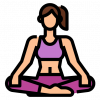Starting a yoga or flexibility practice is exciting, but turning it into a regular part of your life takes more than motivation. For many people, the hardest part is not the poses or the stretches—it’s showing up consistently.
Fortunately, you don’t need hours of free time, extreme willpower, or a perfect routine to build the habit. What you need is structure, patience, and a method that fits your lifestyle. This guide offers simple, proven steps to help you build a lasting daily practice—without pressure or burnout.
1. Start Small and Specific
One of the biggest mistakes beginners make is trying to do too much too soon. A 60-minute session sounds impressive, but it’s difficult to sustain if your schedule is tight.
Instead, try this:
- Begin with just 5–10 minutes per day
- Focus on 1–2 areas (like hips or shoulders)
- Use the same short routine for at least a week
Consistency matters more than intensity. Small wins build momentum—and confidence.
2. Attach Your Practice to an Existing Routine
Habits form more easily when they are connected to something you already do. Choose a moment in the day that happens regularly and place your practice right before or after it.
Examples:
- Right after brushing your teeth in the morning
- Before your evening shower
- After finishing work or a daily walk
This simple pairing makes your practice easier to remember and harder to skip.
3. Create a Dedicated Space
You don’t need a full studio to practice—but having a familiar corner in your home signals your brain that it’s time to move and breathe.
Tips for setting up your space:
- Keep your mat visible and easily accessible
- Add a folded blanket or cushion for comfort
- Minimize distractions (like phones or clutter)
It’s not about perfection—it’s about creating an atmosphere that invites calm and focus.
4. Use Guidance, Not Guesswork
If you’re unsure what to do, you’re more likely to procrastinate or skip the session. A clear structure removes hesitation.
You can:
- Follow a short video from our Yoga & Flexibility Essentials library
- Use printable pose sequences or checklists
- Repeat the same simple flow for a week, then switch
Repetition is not boring—it’s powerful. Familiar routines help the mind settle, and the body adapt.
5. Track Progress with Curiosity
Don’t measure your success only by flexibility or how “deep” you can go into a pose. Instead, notice small changes in how your body feels.
What to observe:
- Do you feel more open after your sessions?
- Is your posture better during the day?
- Are you breathing more deeply and calmly?
Keeping a simple log or journal (even one word per day) can deepen awareness and motivation.
6. Make It Enjoyable, Not a Chore
You’re more likely to stick with something that feels good—physically and emotionally. Choose music you like, use gentle lighting, or practice with calming scents.
Give yourself permission to adapt your routine. Some days, you might do a full sequence. Other days, you might just sit and breathe. Both are valid. Flexibility in the mind is just as important as in the body.
7. Be Patient—and Keep Going
Progress isn’t always visible right away. There may be days when you feel tight, tired, or distracted. That’s okay. The key is to return—not to be perfect.
Missed a day? Just continue tomorrow. One skipped session doesn’t undo your habit. Your body will thank you for returning, again and again.
Final Thoughts
Daily yoga and stretching aren’t about discipline alone. They’re about making space—for movement, for calm, for yourself. When approached with kindness and consistency, even a few minutes a day can reshape your posture, your energy, and your mindset.
The habit begins with one small session. Make it today.

